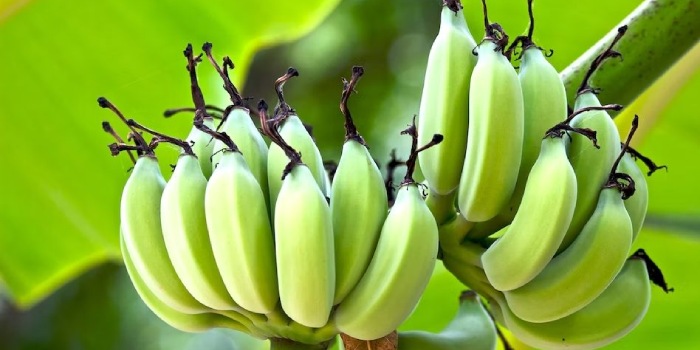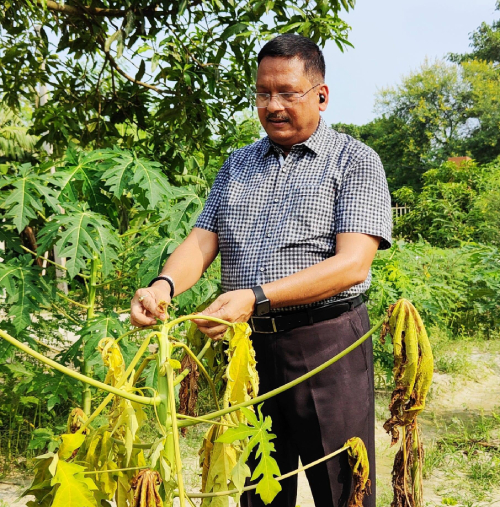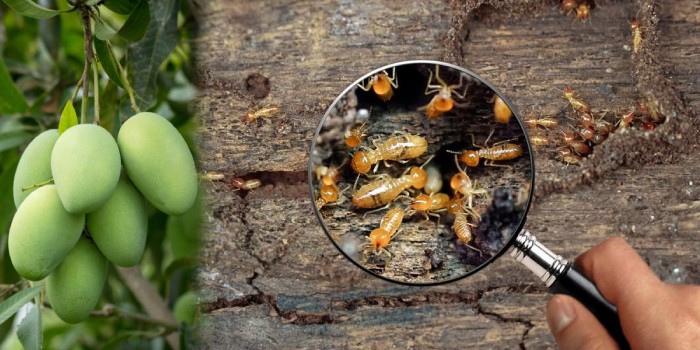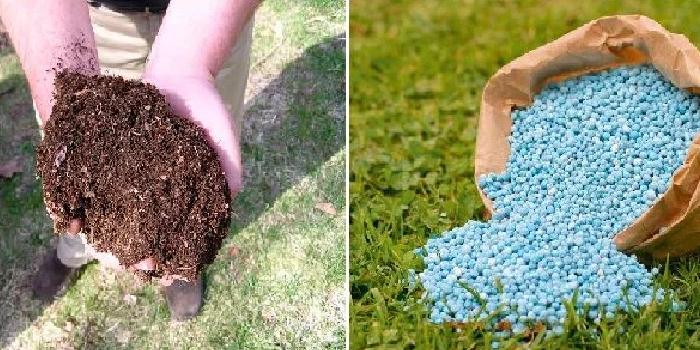
Definition and classification of Manure and Fertilizer
- Raghvendra Kumar Kushwaha –( Research Scholar PG)
- Guru Dayal - (Field Coordinator)*
M.Sc. (Agri.) Soil Science,
Sam Higginbottom University of Agriculture,
Technology and SciencesAllahabad-211007,U.P
Corresponding author Gmail- rkk18200@gmail.com
*Self-Reliant Initiatives Through Joint Action (SRIJAN),
Regional office, Mahavir Nagar,
Manikpur, Chitrakoot, U.P.
Gmail– gurudayal20195@gmail.com
Abstract- More focus was placed on manure and fertilizer after the green revolution (1966-1967) in order to maximize productivity. What is manure how is it prepared, and attention has been placed on the classification of manure and scientific methods of its preparation have all been covered in length in this chapter. In addition, the amount of nutrients it contains has been described. In addition, what kind, how much, and what percentage of nutrients are contained in the fertilizer. In- depth discussion has been had on each of these points. Additionally, the way in which they are prepared has been described. In addition to this, it describes the conversion factors of nutrients. Additionally, the C:N ratio has been described, and some significant issues with this chapter have also been covered in a methodical way.
Introduction of Manure- Manure is a very old and high- quality material that can be utilised in the soil to boost soil productivity because it includes large amounts of the minerals nitrogen, phosphorus, and potash. Manure is frequently consisting of animal feces as well as the decayed remains of dead plants and animals. Because organic fertilizer are used, there is good growth and production. It is incredibly rich in humus. By applying organic manure to a field, the soil’s physical, chemical, and biological qualities are improved, and the nutrients are progressively made available to the plants. When used in the field, its effects last for two three years. The word “manure” comes from the French word “manoeuvrer,” which means to labour with soil. In addition, the words “manure” and “operate,” which both indicate “ to work in Latin,” were used to create the English word. It is also known as organic fertilizer with low analysis. Manure is an organic material that might be from a plant, an animal, or a human.
“Manure is an organic material that is typically created by the breakdown of garbage, dead plants, and animals. By utilizing them in the field, the soil’s quality is enhanced and increased production is accomplished. It is known as manure.”
There are numerous nutrients in it. Compost, green manure, poultry manure, oil cake manure, FYM (Farm Yard Manure), and human excreta manure are a few examples of this.
Classification of Manure- Manure is categorized as having high quality nutrients that are easily absorbed by plants and utilised in fields to increase soil fertility and plant health. Based on its utility to humans and their need, it is split into two sections.
- Bulky organic manure
- Concentrate organic manure
Manure
a) Bulky organic manure
FYM (Farm Yard Manure)
- Cattle manure
- Sheep manure
- Poultry manure
Green Manure
- Green leaf manure
- In-situ green menruing
Compost
- Urban compost
- Village compost
- Vermicompost
Human habitation waste
- Night soil
Agro- based industry wastes
- Mollasses and cotton dust
b) Concentrated organic manure
1. Animal Origin
- Blood meal
- Horn meal
- Fish meal
- Bone meal
- Bird product guano
2. Plant Origin
A. Edible oil cakes
- Groundnut cake
- Sesame cake
- Linseed cake
- Mustard cake
B. Non- Edible oil cakes
- Neem cake
- Mahua cake
- Castor cake
- Sunflower cake
1. Bulky organic manure- Bulky organic manure is defined as manure that has a high concentration of organic materials and moves slowly through the soil. It contains a variety of manure types. Which are listed below.
- Farm Yard Manure
- Compost
- Green Manure
- Human habitation waste
- Agro- based industry wastes
A. Farm Yard Manure- This sort of manure is it. It is produced utilizing animal waste, such as cow dung. Decent farmyard manure must be prepared for at least one to three months and is applied to the soil three to four weeks before sowing. In general, crops utilise 10-15 tonnes/ha of FYM manure. However, fruit trees and vegetables demand 10-20 Kg and 20-25 tonnes, respectively, of FYM. In the field, a 10 tonnes FYM provides 50 Kg of nitrogen, 25 Kg of phosphorus, and 50 Kg of potash with a C:N ratio of 20-30:1. Regarding its nutrients, accessible forms of nitrogen, phosphorus, and potash total 0.5%, 0.25%, and 0.5%, respectively Farm Yard Manure can be prepared using one of three main techniques to which this relates.
- Traditional Method
- Trench Method
- Pit Method

Picture 1- Farm Yard Manure
Source- Niall Claffey (2018).
|
Method |
Size (Length ˟Width˟ Depth) |
Important Points |
|
Trench Method |
6m˟2m˟1m |
C.N. Acharya developed. Within three months, ready to use. |
|
Pit Method |
3m˟ 2m˟1m |
Five to six months for decomposition. |
Table 1- Preparation techniques for Farm Yard manure.
|
Manures |
Nitrogen (%) |
Phosphors (%) |
Potash (%) |
|
Sheep and goat |
0.75 |
0.50 |
0.45 |
|
Poultry |
1.46 |
1.17 |
0.62 |
|
Pig |
0.55 |
0.50 |
0.40 |
|
Cow |
0.40 |
0.20 |
0.10 |
|
Bullock |
0.40 |
0.20 |
0.10 |
|
Horse |
0.55 |
0.30 |
0.40 |
Table 2- Various kinds of nutrients and farmyard manure.
B. Compost- A biological process called compost makes more nutrients available than farmyard manure. It is created utilizing both municipal and agricultural garbage. It is made by aerobic and anaerobic micro-organisms breaking down organic materials. Typically, vegetable crops use 20-25 tonnes/ha while field crops utilise 10-15 tonnes/ha.
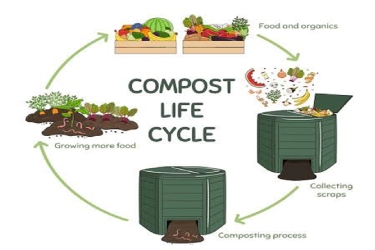
Source- M. Malinika (2022).
Classification of Compost- The process of composting is biological. It is recommended to have 15-25% moisture in it when creating this. Scientists have categorized on the basis of many categories. Which goes like this.
- Based on the Substrate used
- Based on the temperature
- Based on the usage of Oxygen in composting
1) Based on the Substrate used- There are two categories.
a). Rural Compost- Plant leaves and crop waste and animal manures are used to create The rural compost.
b). Urban Compost- Urban compost is where night soil and other organic waste are Stored.
2) Based on the temperature- Compost is primarily separated into two portions, which are as follows, according to temperature.
a) Mesophilic Compost- For this, temperature between 20-50° are thought to be ideal for preparation.
b) Thermophilic Composting- For this, temperature between 40-65° are thought to be ideal for preparation.
3) Based on the usage of Oxygen in composting- Divided into two categories.
a) Aerobic method- Composting with oxygen is done.
b) Anaerobic Method- Composting without oxygen is done, such as the Bangalore method.
Method of Composting- A number of techniques are used to create compost. It can be prepared using the following method, which have been suggested by various scientists.
- Indore Method
- Bangalore Method
- Nedap Method
- Adco Method
|
Method |
Scientist Name |
Important Point |
|
Indore Method |
Albert Howard & Y. D. Wad between (1924 and 1931) |
Size- 3m ˟ 1.5m ˟ 1m (One trench or pit). Four to five months to prepare.
|
|
Bangalore Method |
C.N Acharya (1939) |
Six to Eight months to prepare. Nitrogen- 0.8 to 1.0%. Cost effective method compare to Indore method.
|
|
Nedap Method |
kaka ( In Maharashtra) |
Three to four months to prepare. Nutrient Content- Nitrogen- 0.5 to1.5% Phosphor- 0.5 to 0.9% Potash- 1.2 to 1.4% |
|
Adco Method |
Herchison and Richards (1921) |
Cow dung is not used to prepare it, ADCO powder is used instead. |
Table 2- Important points and various composting techniques.
Vermicompost- This is also referred to as vermicompost. It is made utilizing various waste materials, including garbage, plant leaves, and cow dung, which are then all broken down by earthworms. It requires two to three months to prepare, and it is recommended to give 10-12 tonnes/ha foe food crops. In terms of nutrients, it contains an appropriate amount of nitrogen (0.6-1.2%), phosphorus (0.13-0.22%), and potash (0.4-0.7%). For this, a pH value of 6.5- 7.5 or a temperature of 25-30° is considered suitable. Additionally, when making vermicompost, it must contain between 50-60% moisture to encourage the growth of earthworms. There are three different kinds of earthworms that can be found in soil.
- Epigeic earthworms- Epigeic earthworms can go up to on meter under the soil.
Example- Eisenia fetida, Pheritima elongate, and Perinips ovosicoli.
b) Endogeic earthworms- These worms can go up to three meters into the soil.
Example- Lumbricus terrestris.
c) Diogeic earthworms- These worms go into the soil 1-3 meters and create horizontal channels.


Picture 2- Picture of Vermicompost pit.
C. Green Manure- Green manure is a types of fertilizer which is buried in the soil of the standing crop in the field after flowering and before pod formation. The manure prepared from this is called green manure. It is divided into two parts which are as follows.
a) In- situ green manuring- We used legume crops to prepare compost inside it.
Example- Sunhemp, Dhaincha, Cowpea, Berseem, and Lucerne.
b) Green leaf menruing- One part is green manure .
Example- Leucaena leucocephala, and Pongamia pinnatau.
2. Concentrate organic manure- There is type organic manure. It contains more nutrients than Bulky organic manure. Various types of manure come under this which are as follows. Example- Blood meal, Horn meal, Fish meal , Bone meal, Groundnut cake, Sesame cake, Linseed cake, Neem cake, and Mahua cake.
|
Organic manure |
N % |
P % |
K% |
|
Edible oil cake |
|||
|
Mustard cake |
5.2 |
1.8 |
1.2 |
|
Groundnut cake |
7.3 |
1.5 |
1.3 |
|
Sesame cake |
6.2 |
2.0 |
1.2 |
|
Linseed cake |
4.9 |
1.4 |
1.3 |
|
Non- edible oil cake |
|||
|
Mahua cake |
2.5 |
0.8 |
1.8 |
|
Castor cake |
4.3 |
1.8 |
1.3 |
|
Neem cake |
5.2 |
1.0 |
1.4 |
|
Karanj cake |
3.9 |
0.9 |
1.2 |



